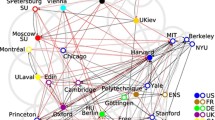Abstract
We use the directed networks between articles of 24 Wikipedia language editions for producing the wikipedia ranking of world Universities (WRWU) using PageRank, 2DRank and CheiRank algorithms. This approach allows to incorporate various cultural views on world universities using the mathematical statistical analysis independent of cultural preferences. The Wikipedia ranking of top 100 universities provides about 60% overlap with the Shanghai university ranking demonstrating the reliable features of this approach. At the same time WRWU incorporates all knowledge accumulated at 24 Wikipedia editions giving stronger highlights for historically important universities leading to a different estimation of efficiency of world countries in university education. The historical development of university ranking is analyzed during ten centuries of their history.
Similar content being viewed by others
References
P.G. Altbach, L. Reisberg, L.E. Rumbley, Trends in Global Higher Education: Tracking an Academic Revolution. A Report Prepared for the UNESCO 2009 World Conference on Higher Education (UNESCO, 2009), http://www.unesco.org/fileadmin/MULTIMEDIA/HQ/ED/ED/pdf/WCHE˙2009/ (accessed Nov. 2015)
E. Hazelkorn, Rankings and the Reshaping of Higher Education: The Battle for World-Class Excellence (Palgrave Macmillan, New York, 2015)
Academic Ranking of World Universities, http://www.shanghairanking.com/ (accessed Nov. 2015)
Enseignement supérieur et recherche, Investissements d’avenir, http://www.enseignementsup-recherche.gouv.fr/pid24578/investissements-d-avenir.html (2015)
Russian Academic Excellence Project, http://5top100.ru/ (accessed Nov. 2015)
Times Higher Education World University Ranking, https://www.timeshighereducation.com (accessed Nov. 2015)
U-Multirank of European Union, http://www.umultirank.org/ (accessed Nov. 2015)
IREG Observatory on Academic Ranking and Excellence, http://ireg-observatory.org/en/ (accessed Nov. 2015)
D. Docampo, Scientometrics 86, 77 (2011)
L. Bornmann, R. Mutz, H.-D. Daniel, J. Am. Soc. Inform. Sci. Technol. 64, 1649 (2013)
H. Jöns, M. Hoyler, Geoforum 46, 45 (2013)
D. Docampo, L. Cram, Scientometrics 98, 1347 (2014)
A. Rauhvargers, Global University Rankings and Their Impact – Report II, European University Association asbl (2013), http://www.eua.be/ (accessed Nov. 2015)
A.O. Zhirov, O.V. Zhirov, D.L. Shepelyansky, Eur. Phys. J. B 77, 523 (2010)
A.A. Markov, Izvestiya Fiziko-matematicheskogo obschestva pri Kazanskom universitete, 2-ya seriya, 15, 135 (1906) (in Russian) [Extension of the limit theorems of probability theory to a sum of variables connected in a chain, reprinted in Appendix B of: R.A. Howard Dynamic Probabilistic Systems, Vol. 1: Markov models, Dover Publ (2007)]
S. Brin, L. Page, Computer Networks and ISDN Systems 30, 107 (1998)
A.M. Langville, C.D. Meyer, Google’s PageRank and beyond: the science of search engine rankings (Princeton University Press, Princeton, 2006)
L. Ermann, K.M. Frahm, D.L. Shepelyansky, Rev. Mod. Phys. 87, 1261 (2015)
S. Dorogovtsev, Lectures on complex networks (Oxford University Press, Oxford, 2010)
Y.-H. Eom, K.M. Frahm, A. Benczur, D.L. Shepelyansky, Eur. Phys. J. B 86, 492 (2013)
Y.-H. Eom, D.L. Shepelyansky, PLoS One 8, e74554 (2013)
Y.-H. Eom, P. Aragon, D. Laniado, A. Kaltenbrunner, S. Vigna, D.L. Shepelyansky, PLoS One 10, e0114825 (2015)
M.H. Hart, The 100: ranking of the most influential persons in history (Citadel Press, N.Y., 1992)
D.L. Shepelyansky, Top 100 historical figures of Wikipedia, https://hal.archives-ouvertes.fr/hal-01184245/ (accessed Nov. 2015)
Country codes ISO 3166-1 alpha-2, https://en.wikipedia.org/wiki/ISO˙3166-1˙alpha-2 (accessed Nov. 2015)
A.D. Chepelianskii, arXiv:1003.5455 [cs.SE] (2010)
WRWU rank data, http://perso.utinam.cnrs.fr/˜lages/datasets/WRWU/ (accessed Nov. 2015)
Web page Maps of the world, http://www.mapsofworld.com (accessed Nov. 2015)
L. Ermann, A.D. Chepelianskii, D.L. Shepelyansky, J. Phys. A 45, 275101 (2012)
L. Ermann, D.L. Shepelyansky, Acta Physica Polonica A 120, A158 (2011)
Wikipedia, The Free Encyclopedia, List of countries and dependencies by population, https://en.wikipedia.org/wiki/List˙of˙countries˙and˙dependencies˙by˙population (accessed Nov. 2015)
M. Bastian, S. Heymann, M. Jacomy, in International AAAI Conference on Weblogs and Social Media, 2009
Author information
Authors and Affiliations
Corresponding author
Rights and permissions
About this article
Cite this article
Lages, J., Patt, A. & Shepelyansky, D. Wikipedia ranking of world universities. Eur. Phys. J. B 89, 69 (2016). https://doi.org/10.1140/epjb/e2016-60922-0
Received:
Revised:
Published:
DOI: https://doi.org/10.1140/epjb/e2016-60922-0




